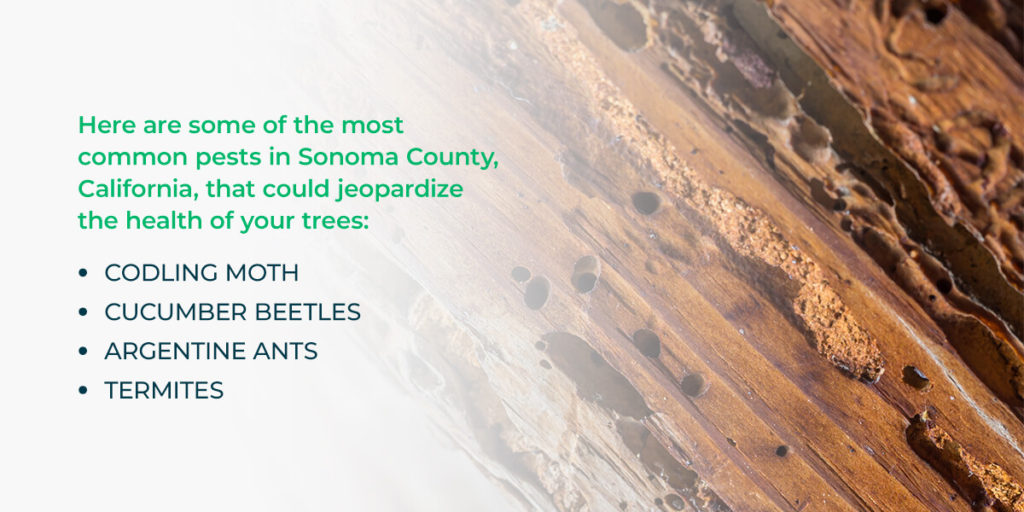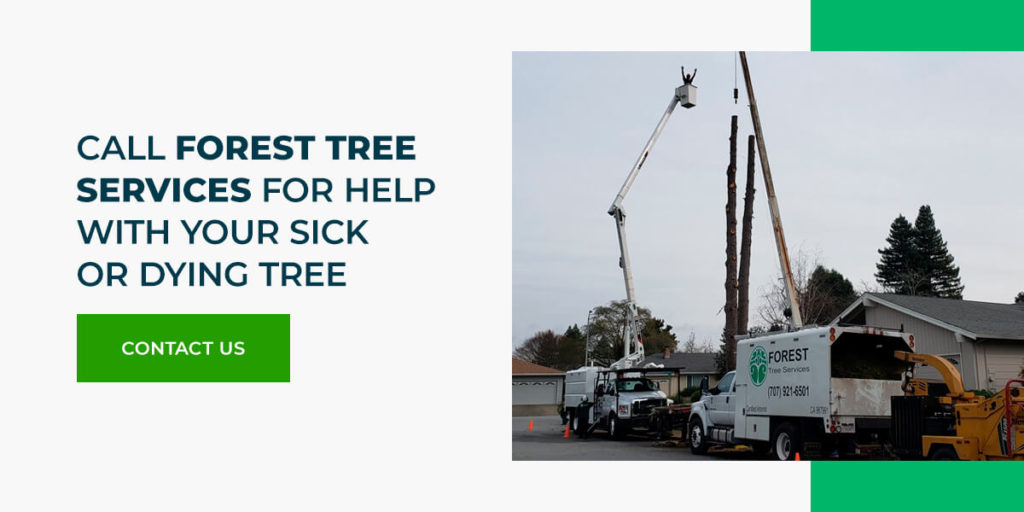
Even the sturdiest trees can become sick and start to wither. Like humans, trees can catch a variety of diseases and suffer from poor internal or external conditions. If you identify a sick tree on your property, there are measures you can take to help it heal and continue living for years to come.
The death of a tree can be disappointing, and it can also be dangerous. After a tree dies, it grows weaker and poses a risk to your property and even your family. Know the signs of a sick tree so you can get it the help it needs before any dangerous situations occur. Use this article to learn what a sick tree looks like so you know if your tree is sick or dead and what you can do about it.
1. Peeling Bark
A tree’s bark is like its skin, and you can tell a lot about a tree’s health by observing its bark. Tree bark acts as a protective layer for the more vulnerable parts of the tree beneath, including the heartwood. The bark is the armor of the tree, and if it starts to peel and fall off, the tree is without its protection from other health dangers. Plus, peeling bark is a sign that the tree could be dealing with internal problems.
Trees may shed their bark when they’re healthy. Healthy bark peeling is minimal and usually occurs when new bark comes up to take the old bark’s place. Animals like bucks may also scrape the bark off trees. A healthy tree will be able to regrow the missing bark in these instances. An unhealthy tree will shed a much larger amount of bark and struggle to replenish what it lost. If you see large patches of exposed wood, your tree may be in trouble.
One reason a tree’s bark could start to peel is that it is having trouble maintaining proper nutrients. But many other reasons for peeling bark exist, so you’ll need the help of a professional arborist to identify the problem. An arborist can pinpoint the exact reason for this condition so you can take the proper next steps to helping your tree become healthy and strong again.
2. Few Leaves or Leaf Discoloration
A healthy tree will produce an abundance of foliage. In the spring and summer, your tree should produce plenty of leaves and provide coverage and shade from the sun. In the autumn season, the tree should lose every leaf by the time winter arrives. If your tree is producing few leaves, no leaves or it is holding onto its dead leaves into the winter, it may be sick or dying.
Leaf colors can also inform you of a tree’s health. A healthy tree will produce green leaves in the spring and summer. In autumn, the leaves will change into shades of red, yellow, orange and brown before separating from the tree and falling to the ground. An unhealthy tree’s leaves may turn brown during the summer or fall while they are still green. These are signs of an issue a professional arborist should address as soon as possible.
3. Fungus
External forces like fungus can cause serious damage to trees, leading to impeded growth and even death. Fungi like theinonotus dryadeus can cause trees as strong as oaks to rot. This fungus first targets a tree’s branches, stunting their growth. It then works its way to the base of the tree, forming visible light brown shelves by the soil. These shelves eventually turn black and hard, causing the tree to rot and fall over.
The inonotus dryadeusis only one type of fungus. Many more types of fungus exist that can make quick work of your trees, causing them to wither and die rapidly. If you notice any strange growths or shapes on your tree, call an arborist right away. When dealing with fungi, timing can be the difference between a tree surviving or dying.

4. Pests
Watch for pests that can infiltrate your tree and cause it to grow sick or die. Some insects and arachnids can be hard to spot, so look for some of the following signs:
- Webbing nests
- Fallen, healthy leaves
- Chewed leaves
- Defoliated branches or mottled foliage
These are just a few of the signs that pests have made their home in the branches, trunk or roots of your tree. To help further your research, here are some of the most common pests in Sonoma County, California, that could jeopardize the health of your trees:
- Codling moth: These moths begin as caterpillars that find their way into the fruits of your fruit-bearing trees. When they are present, you may notice an increased number of your fruits dying prematurely.
- Cucumber beetles: Sonoma residents may find cucumber beetles in their gardens, but these pests can also make their way to stonefruit trees.
- Argentine ants: You can spot Argentine ants traveling in lines along the branches of your trees. They forage for sweets, fruits and oils near their homes, which can cause tree damage.
- Termites: Many people have experienced the destructive force of termites before. Once they start feeding on your trees, they can cause irreparable harm. Contact a professional right away if you notice termites on or near any of your trees.
Pests can be impossible to beat on your own, so make sure you call a professional arborist to help remedy the situation.
5. Root Issues
Root rot is a serious issue that can lead to a tree’s demise. Healthy roots are critical in a tree absorbing its essential nutrients. If its roots start rotting away — usually as a result of fungi — the tree may have little time left. You may spot fungi in a tree’s branches before it spreads to other parts of the tree. Have a professional arborist prune your tree before the fungus has a chance to reach the roots.
The ground around your tree’s roots can also affect its health. Parched ground is a sign your tree may be lacking the proper amount of water to stay healthy. Soft, muddy ground can reveal your tree is unable to absorb the right amount of water into its roots or that it is receiving too much water. Loose ground can also lead to a tree becoming unstable and falling over, which can mean the end of your tree’s life unless you get professional help in time.

Call Forest Tree Services for Help With Your Sick or Dying Tree
Take action right away by calling the professionals at Forest Tree Services if you have a sick or dying tree. Our full range of services can help make your trees healthy again and keep them strong for years to come. Our professional arborists are ready to identify your tree’s health problem and implement the right solution.
Contact us today for more information!
